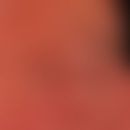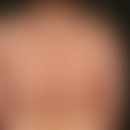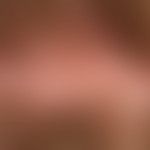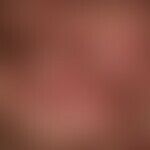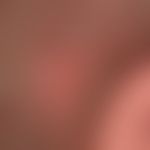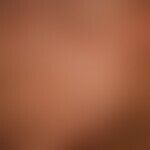Synonym(s)
HistoryThis section has been translated automatically.
Charles Quinquaud 1888.
Darier describes folliculitis décalvans as a variety of Brocq's pseudopelade, thus giving the pseudopelade an independent etiopathogenetic meaning, which it no longer has according to today's general definition. According to today's understanding, the pseudopelade is not a nosological entity, but denotes the final state of etiopathogenetically different, pathological processes.
DefinitionThis section has been translated automatically.
Rare, eminently chronic, follicular (neutrophilic) inflammation of the capillitium, with inflammatory, follicular papules and pustules, leading to complete destruction of the hair follicles and consecutive scarring, which is self-perpetuating. The secondary condition is a mirror-like, scarring alopecia with single tufted hairs (=tufted hairs; see also folliculitis sycosiformis atrophicans). Characteristic is the detection of Staphylococcus aureus from pustule contents and the appearance of tufted hairs in the scar areas.
You might also be interested in
EtiopathogenesisThis section has been translated automatically.
Unexplained, possibly persistent infection with Staphylococcus aureus (S. aureus is almost always detectable from pustules and hair roots) possibly on the basis of a localized immune deficiency.
Familial clusters are occasionally observed, but are the absolute exception.
In rare cases, an association with hidradenitis suppurativa can be detected (see case example).
Folliculitis decalvans has also been described several times in combination with pityriasis amiantacea as a paradoxical ADR during treatment with TNF-alpha antagonists (Zamperetti M et al. 2017).
ManifestationThis section has been translated automatically.
Preferably occurring in adulthood (20-40 years).
Men are affected much more often than women (ratio about 5:1).
LocalizationThis section has been translated automatically.
capillitium:
- Parietal region (by far the most common region)
- Temple region
Facial area: Similar skin changes can also occur in the facial area (folliculitis decalvans faciei).
ClinicThis section has been translated automatically.
Eminently chronic inflammatory, pyogenic folliculitis of the capillitium.
Frequently continuous or relapsing course of the disease for years (sometimes decades), which becomes sessile only after local scarring associated with hairlessness.
Initially disseminated, small, follicular, moderately painful, discrete red papules. In the course of disease progression, increasing inflammatory symptomatology with follicular pustules, incipient patchy, later also extensive, mirror-like skin atrophy with hairlessness. Characteristic are keratotic hair shaft precipitations near the hair base at the edge of the lesions. Rice-field-like conglomerate follicles form (tuft hair formation).
After formation of a central, plate-like, mirror-like, hair- and follicle-free scarring (glossy skin), folliculitides are found only in the marginal zone of the foci. These are the signs of progression of the disease.
Findings: Few or numerous, irregularly shaped, atrophic, 2.0-5.0 cm large, hairless, plate-like, sunken foci of scarring with peculiar atrophic shiny skin, which is particularly conspicuous in lateral illumination and observation.
Formation of so-called tufted hairs, starting from large-lumen dilated pores, comprising 5-15 tightly clasped hair bundles.
The margins of the lesions appear frayed with active papulo-pustular inflammatory fringe.
HistologyThis section has been translated automatically.
Fresh lesion: Perifollicular abscesses of poly- and mononuclear cells, consecutive destruction of hair follicles. Older foci show perifollicular granulation tissue composed of lymphocytes, fibroblasts and plasma cells, often with foreign body giant cells.
In burned-out foci, only fibrosis with sparse lymphocytic infiltrates is seen.
Differential diagnosisThis section has been translated automatically.
Scarring alopecia of other etiology (e.g. lichen planus follicularis).
Tinea capitis (microscopic or cultural fungal detection).
Folliculitis-decalvans-like changes in severe acne conglobata.
External therapyThis section has been translated automatically.
Disinfecting externals: with antimicrobial additives such as diluted potassium permanganate solution(light pink), hydroxyquinoline e.g. quinolinol (e.g. quinosol 1:1000), R042, clioquinol cream R049.
Alternative antibiotics: erythromycin-containing solutions (e.g., R086, acnemycin solution).
Alternative glucocorticoids: topical glucocorticoids as creams or solutions, e.g. betamethasone 0.05% lotio or ointment(betamethasone valerate emulsion hydrophilic), possibly under occlusive conditions. Also alternate with topical antibiotics.
Here, topical application of BPO/clindamycin (=Duac Acne Gel®) and halometasone 0.05%/triclosan 1% (=Infectocortisept®) in daily alternation has proven effective in case reports.
Calcineurin inhibitors: Single results are available for Tacrolimus.
PDT: Also reported in the literature are successes with PDT therapy with Metvix® and LED red light, 37 J/cm², 4x at 4-week intervals.
Internal therapyThis section has been translated automatically.
Tetracycline (e.g. Tetracycline-Wolff) initially 1 g/day p.o., later reduction to 500 mg/day. Therapy trial with isotretinoin (e.g. isotretinoin-ratiopharm; Aknenormin) 0.5 mg/kg bw/day.
Alternative clindamycin/rifampicin: In some cases, good therapeutic effects are described with the combination of clindamycin and rifampicin (Bunagan MJ et al. 2015): Clindamycin/Rifampicin 300mg 2x/day for 10 weeks (Vañó-Galván S et al 2015).
Alternatively Oral fusidic acid (3x500mg/day) for a period of 3-4 months (Pimenta R 2019).Single case reports showed positive success with combination therapy of dapsone (100 mg/day) and isotretinoin (1 mg/kgKG/day) and adalimumab (Shireen F et al. 2018).
Alternative isotretinoin: In the rare combination with acne vulgaris, therapy with isotretinoin is recommended.
For more severe inflammation, short-term glucocorticoids in medium doses 60-80 mg/day (e.g. Decortin H) in decreasing doses.
Experimentally, apremilast (oral thalidomide analog): One casuistry reports successful therapy with apremilast (Fässler M et al 2020).
AftercareThis section has been translated automatically.
It is recommended to surgically remove the tufted hairs, as they represent an entry point for bacteria. For recurrence prophylaxis, a disinfecting shampoo should be chosen. The scalp should be blow-dried dry after scalp washing.
Case report(s)This section has been translated automatically.
A 41-year-old man from Cape Verde has been suffering from a painful, purulent, locally oozing folliculitis on the vertex of the scalp for two months. The patient had been diagnosed with human immunodeficiency virus type 1 (HIV-1) infection 5 years earlier. He was taking a treatment combination of efavirenz, tenofovir, and emtricitabine. Meanwhile, the viral load was undetectable.
Dermatologic examination revealed an inflammatory plaque with scarring alopecia with crusts and follicular pustules. Direct microscopic examination and mycologic culture revealed no fungal elements. Folliculitis decalvans was diagnosed.
Systemic therapy: The patient received 500 mg of oral fusidic acid three times daily.
Local therapy: Betamethasone dipropionate 0.05% and salicylic acid 3% lotion and azelaic acid 5% lotion once daily.
Course: After two months of treatment, the patient showed clinical improvement with less redness. Regression of the purulent folliculitis. Hair regrowth was noted, mainly in the marginal area of the lesion. After 3 months, antibiotic therapy was discontinued. Local therapy was continued for 6 months.
LiteratureThis section has been translated automatically.
- Bolz S et al (2008) Successful combined isotretinoin and dapsone therapy for perifolliculitis capitis abscedens et suffodiens. JDDG 6: 44-47
- Bunagan MJ et al (2015) Retrospective Review of Folliculitis Decalvans in 23 Patients with Course andTreatment
Analysis of Long-standing Cases.J Cutan Med Surg 19:45-49. - Chandrawansa PH et al (2003) Folliculitis decalvans--a retrospective study in a tertiary referred centre, over five years. Singapore Med J 44: 84-87
- Vañó-Galván S et al (2015) Folliculitis decalvans: a multicentre review of 82 patients. J Eur Acad Dermatol Venereol 29:1750-1757.
- Karakuzu A et al (2001) A case of folliculitis decalvans involving the beard, face and nape. J Dermatol 28: 329-331
- Kaur S, Kanwar AJ (2002) Folliculitis decalvans: successful treatment with a combination of rifampicin and topical mupirocin. J Dermatol 29: 180-181
- Pimenta R (2019) Successful Treatment with Fusidic Acid in a Patient with Folliculitis Decalvans. Acta Dermatovenerol Croat 27: 49-50.
- Powell JJ et al (1999) Folliculitis decalvans including tufted folliculitis: clinical, histological and therapeutic findings. Br J Dermatol 140: 328-333.
- Quinquaud CE (1888) Folliculite épilate décalvante. Réunions clin Hôpital St. Louis, Comptes rendus (Paris) 9: 17.
- Shireen F et al.(2018) A Case of Isotretinoin Therapy-Refractory Folliculitis Decalvans TreatedSuccessfully
with Biosimilar Adalimumab (Exemptia).Int J Trichology 10:240-241. - Vañó-Galván S et al (2015) Folliculitis decalvans: a multicentre review of 82 patients. J Eur Acad Dermatol Venereol 29: 1750-1759.
- Fässler M et al (2020) Successful treatment of refractory folliculitis decalvans with apremilast. JAAD Case Rep. 20;6:1079-1081.
Zamperetti M et al (2017) Pityriasis amiantacea and folliculitis decalvans An unusual manifestation associated with antitumor necrosis factor-α therapy [Pityriasis amiantacea and folliculitis decalvans: An unusual manifestation associated with antitumor necrosis factor-α therapy]. Dermatologist 68:1007-1010.
Incoming links (24)
Acne decalvans; Acne décalvante; Acne keloidalis nuchae; Acne necrotica; Apremilast; Betamethasone valerate emulsion hydrophilic 0,025/0,05 or 0,1 % (nrf 11.47.); Clioquinol cream 0.5-2% (o/w); Eec syndrome; Erosive pustular dermatosis of the scalp; Erythromycin solution ethanol containing 0,5/1/2 or 4 % (nrf 11.78.); ... Show allOutgoing links (20)
Adverse drug reactions of the skin; Alopecia (overview); Apremilast; Betamethasone valerate emulsion hydrophilic 0,025/0,05 or 0,1 % (nrf 11.47.); Calcineurin inhibitors; Clioquinol cream 0.5-2% (o/w); Erythromycin; Erythromycin solution ethanol containing 0,5/1/2 or 4 % (nrf 11.78.); Folliculitis sycosiformis atrophicans; Fusidic acid; ... Show allDisclaimer
Please ask your physician for a reliable diagnosis. This website is only meant as a reference.

